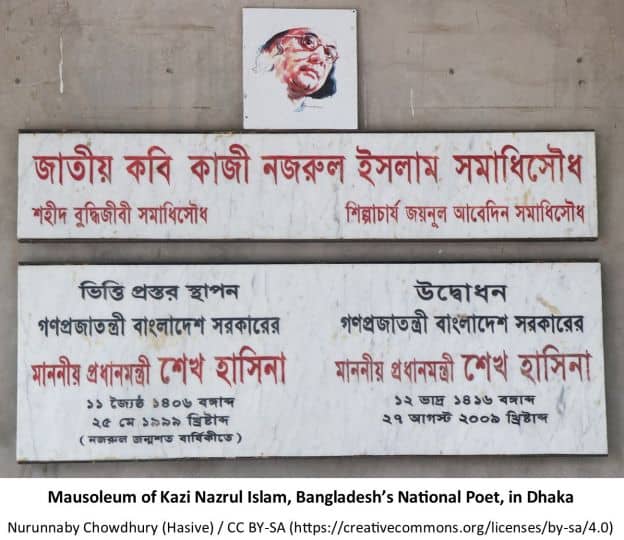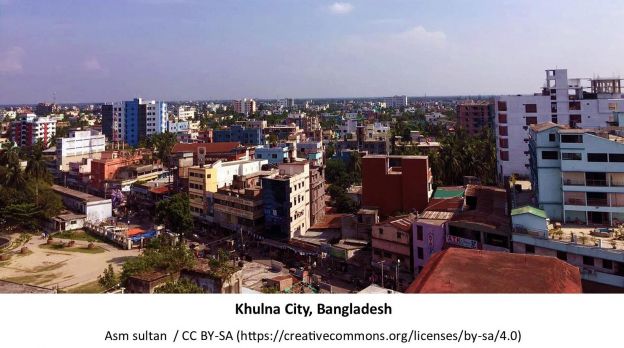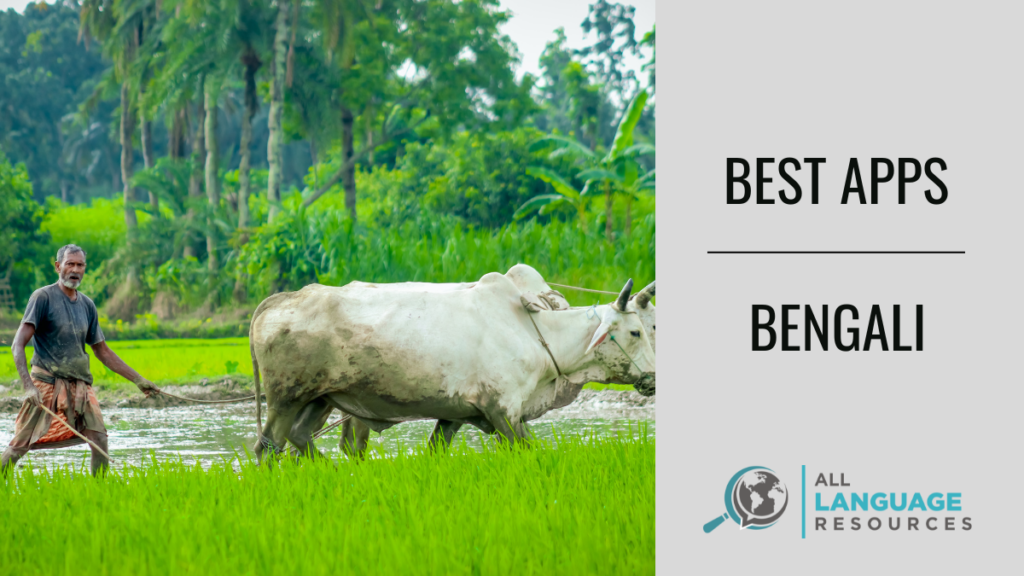Did you know that Bengali is among the top ten most spoken languages in the world?
Bengali, also known as Bangla, is the native language of the Bengal region of South Asia – the modern-day Bangladesh and other Indian states.
With the abundance of resources available online, we understand that choosing the right one for you can be overwhelming. That’s why we’ve done the hard work for you, we’ve tested a variety of resources ourselves and compiled them here for you.
In this post, we’ll explore the best and recommended apps, courses, podcasts, and YouTube for all levels to help you narrow down your choices and direct your focus on learning Bengali.
Table of Contents
Learn Bengali Online: Resources for Learning Bengali Language
Using a combination of written, audio, and video resources, you can familiarize yourself with the Bengali alphabet and language. As you continue learning, you will slowly but steadily build your reading and listening comprehension.
Learning the Bengali Alphabet
If English is your native language, writing Bengali will take some getting used to.
Bengali is written using Bengali script, also called the Bengali alphabet (bangla bôrnômala).
Bengali script descends from the Brahmic script family. In addition to representing written Bengali, the script is also used by several related languages, including Manipuri Bishnupriya (spoken in Manipur and Assam).
Although eleven of its fifty letters are technically vowels, Bengali script is an abugida. Also called an alphasyllabary, this is basically an alphabet in which vowels can be represented as diacritical or “accent” marks attached to consonants.
In essence, the consonants in this form of writing system have “built-in” vowels. However, these vowels can have more than one pronunciation, and it’s sometimes unclear which vowel pronunciation should be used…if, indeed, the vowel should be pronounced at all.
Some of the consonant-vowel combinations form ligatures (or “conjunct letters”), connecting two or more letters together.
You may have seen similar scripts at your local Thai restaurant. Numerous other languages use them, including Ethiopian, Cree, and Tamil. Even certain forms of shorthand writing might be considered abugidas.
Bengali script lacks distinct capital or lowercase letters, so it can be difficult to pick out proper names. Like the Latin alphabet, though, it is written from left to right and runs horizontally across the page. At present, there is no single established transliteration for representing Bengali words phonetically in the Latin alphabet.

One of the easiest ways to start grasping Bengali letters and their pronunciations is to learn like a child. YouTube has a slew of Bengali alphabet videos made for children. This colorful alphabet video from ABC Learning School introduces each Bengali letter slowly. The letters are repeated and paired with a representative word and phrase.
The Banjonborno song from Kheyal Khushi uses a cartoon classroom to rapidly review each Bengali letter and an associated word. It goes fairly quickly, so it’s probably better for reinforcement than an initial introduction to the writing system.
If you prefer a more mature, scholarly approach, the RASILa raju Institute presents Learn Bengali Consonants Reading & Writing Through English.
Audiovisual resources like these videos will help you learn the look and sound of Bengali letters. To really internalize this knowledge, you’ll want to practice writing. There are a few useful texts on the market, such as Isaul Karim’s Learning Bengali Alphabet for English speakers: Teach Yourself Bengali (Bangla) alphabet, which shows how to trace each letter step-by-step, gives examples of the sound it makes, and provides worksheets for you to trace the letters.
Scrap paper or notebooks can also be used to practice writing your Bengali letters. Another option is a drawing program on your phone or even a dry-erase board.
To practice typing in Bengali, check out this list of Bengali script word processors and typing tutors for Windows or Mac. You can also type in Bengali online without installing any software by using the Bangla Keyboard on Branah.com—or the Lexilogos Bengali Keyboard.

There are also several Bengali keyboard apps available for your mobile devices, such as Easy Bangla Keyboard and Bengali Keyboard 2020. Since most virtual keyboards don’t include the Bengali alphabet, installing one of these apps can help you with language learning exercises—as well as chatting and texting in Bengali.
If you start learning Bengali with a formal language course, the alphabet should be one of the first topics covered. It never hurts to have these additional resources for reinforcement and review, though.
Bengali Language Lessons, Classes, Courses
ILanguages offers free Bengali lessons for beginners. (The site refers to the language exclusively as “Bangla,” so don’t search for “Bengali!”) The vocabulary focuses on some of the most common words and phrases used in the language so that you can quickly boost your comprehension.
The words and phrases are presented in both written and audio form. The sound quality for the audio can be a bit tinny, but most of the clips are clear enough to understand. There are also a few grammar examples and lists of pronouns, adverbs, and possessives.
ILanguages has quizzes and over two hundred interactive flashcards to help you test your Bengali knowledge. Although the flashcards show both the Bengali script and the phonetic version of the word, the quizzes use only the phonetics.
The iLanguages site isn’t fancy and feels like a flashback to the Nineties, but it’s a good way to dip your toe in the water.
The Peace Corps has a free introductory Bengali course that includes an extensive section on the alphabet…even delving into the technicalities of Bengali phonetics. If you like to get deep into distinctions of trills, aspirations, nasals, and spirants, you’ll appreciate the level of detail in the Alphabet section.
About a third of the way into the curriculum are sixteen lessons covering topics such as greetings, numbers, food, and family. After the section on the alphabet and its pronunciation, the lessons are primarily conversation-based, with little or no grammar. Most of the lessons have dialogues, which are both read aloud and written phonetically and in standard Bengali—and also translated into English.

You can download the Peace Corps Bengali course, which is hosted on the Live Lingua Project site. Each of the accompanying audio files must be downloaded separately, which is a bit tedious. A browser plugin such as Down Them All! can expedite this process by letting you grab all ten audio files at once.
50 Languages has a free online Bengali course with 100 lessons. The lessons correspond to levels A1 and A2 in the Council of Europe’s Common European Framework of Reference for Languages (CEFR), a major standard for assessing knowledge of a given language.
Audio recordings by a male and female native speaker give you the chance to hear each word or phrase two times in different vocal registers, which can sometimes make it easier to hear certain nuances. The written component includes an English translation, the original Bengali script, and a phonetic transliteration.
You can hide or reveal parts of the phonetic version to help you rely more on the Bengali script, and the text size for the entire page is adjustable—perfect for zooming in on those Bengali characters so you can see the details better.
The 50 Languages course allows you to download all the audio as MP3s for offline use; however, the written material is not included. Another option is to use the 50 Languages app to take their Bengali course on your Android or iOS device.
Mango Languages takes its typical conversation-based approach to break down basic Bengali into bite-sized lessons. It distinguishes between formal and informal language…and is often a good source of casual language and slang.
As you work your way through the Mango Languages Bengali lessons, you’ll have the opportunity to see, hear, and speak with introductory Bengali conversations. The lessons use repetition and modular language components to teach you how to build sentences.
For instance, you will first be introduced to an entire phrase, such as “What is your name?”. You will then learn each word in the phrase, and afterwards practice putting the component words together in different combinations.
Mango Languages also intersperses grammar points and cultural tidbits, so you can get more of a well-rounded understanding of what you’re learning. Like the 50 Languages course, it’s also available for iOS and Android. Since many public libraries sponsor Mango Languages subscriptions for their patrons, there’s a good chance you can enjoy these lessons for free.

Glossika is also a good way to force yourself to speak the language. It’s a bit on the pricey side and lacks instruction in grammar. However, the design of the course will help you to absorb the language in a more natural manner, much the way you might have done if you’d learned Bengali as a child.
Apps to Learn Bengali
Here are a few apps that can get you started with your Bengali learning adventure.
Ling App
If you felt horrified when you learned that the popular game-like language program Duolingo does not offer Bengali, the Ling App may provide exactly what you need. Just like Duolingo, Ling offers short, gamified lessons with lots of mini-rewards for each achievement you unlock. This approach works well to keep a beginning language learner motivated.
Ling’s big advantage is that it offers lessons for many “less popular” languages. The Ling App offers 200 short lessons covering the basics of Bengali. The lessons do not dive too deeply and don’t always come with thorough explanations, but the program gives you a good introduction to the basics of the language and helps you build a library of core vocabulary.
You may also find it helpful if you want a crash course to get ready for a trip to a Bangla-speaking part of the world. Ling uses recordings of native speakers in all lessons and interactive activities, so you can train your ear with accurate pronunciation of the tricky T and D sounds in Bengali.
The downside to this fun app is that it does have a medium-high subscription fee. You can choose to pay by month, by year, or simply purchase a lifetime access.
Hindustani Tongue
Hindustani Tongue is an answer to our collective Bangla students’ prayers. It is a 1-on-1 tutoring course with native teachers, and compared to other tutoring platforms, its teachers go through robust training sessions and there is a framework of basic language learning progressions. This takes much of the guesswork out of picking teachers that plagues other tutoring platforms, and it truly is a great online language course option for Punjabi learners.
Another great thing about Hindustani Tongue is that your previous lessons are all available in Google Classroom for you to review for as long as you are a student! And you can ask questions to your teacher via chat any time. If you need to change your teacher, that’s easy to do by simply requesting it to the admin.
Hindustani Tongue 1-on-1 tutoring sessions are reasonably priced compared to other programs. You can buy a bundle of 50 lessons for $299 (but ALR readers can receive a discount by using our coupon code) and it comes with a 40-day money back guarantee.
Mondly
Like Ling, Mondly offers fun, ten-minute lessons to help you easily master the fundamentals of Bengali. You can set the app to learn as an English speaker or to learn Bengali as a Hindi speaker. This is a unique feature that really sets Mondly apart from many other language apps.
Plus, Mondly uses a gamified approach with rewards for consistent “streaks” of signing in every day to complete short lessons, finish quizzes, and so on.
Another great thing about Mondly’s Bengali course is that it has lessons on learning the script. While you may think that literacy is not as important as speaking Bengali, you will do better if you learn the script early on.
As you know, the Bengali script is quite different from the English alphabet, with its 50 letters. As a fun fact, the Bengali script ranks as the fifth most used writing system in the world!
That said, Mondly is not the best choice for an advanced Bangla student. It works best to introduce a beginner to language basics like core vocabulary, basic grammar, the script, and simple pronunciation rules. Lessons do not progress far beyond these basics.
Mondly has a slightly higher monthly subscription fee than Ling, coming in at $10 per month or $48 per year.
Italki
If you have difficulty focusing on app-based lessons and zone out when listening to an audio course, you may thrive in a one-on-one learning environment. Italki offers a portal to hundreds (or even thousands) of professional language tutors.
The app allows you to narrow your search for your perfect teacher by pinpointing the schedule, price point, or level of experience you want. You will see how many lessons a tutor has offered through Italki right under their profile, along with a five-star rating system.
The obvious downside to embarking on a tutoring program is the cost. Italki tutors set their own rates and charge anywhere from as little as $10 per hour to as much as $60 per hour. More experienced tutors often charge more, as you would expect!
The huge benefit is that you can ask your tutor to focus on what you need to learn. As a beginner, you may want basic lessons covering essentials like grammar, the alphabet, and pronunciation. But as a more advanced learner, you will quickly find that the huge advantage of working with a tutor is the ability to practice conversation. This will build your confidence in a safe setting, help you learn core vocabulary, and perfect your pronunciation.
Plus, informal or colloquial Bangla often sounds quite different from the formal version of the language you learn in a textbook. In fact, Bangla has two official forms: the formal language, known as the Sadhubhasa version, and the informal Chaltibhasa version.
Key cultural elements like hand gestures also make more sense when you learn them in person. Working with a tutor can help you prepare for everyday conversation.
If you can’t afford a tutor, HelloTalk is another great app that helps you connect with conversation partners around the world for free. You won’t get lessons, but you will make new friends and get a chance to converse out loud in your new language!
Preply
Like Italki, Preply is an app that connects you to experienced language tutors. You don’t have to worry about finding tutors for a language like Bengali, as Preply prides itself on working with over 49,000 tutors around the world.
Just like in the Italki app, Preply allows you to search for a tutor by language and availability. The pricing model is less flexible than it is in Italki, as you have to commit to buying a package of lessons in Preply. You do not get a free trial lesson, but you do have the option of a discounted first lesson before you commit to buying a full lesson package with a particular tutor.
Tutors offer highly customized lessons based on your own personal needs as a language learner. You also get to take a placement test, so your tutor can offer work at your own level.
Another advantage Prepl offers is an online community and blog where you can connect with fellow Bengali learners.
The disadvantage of Preply is that it has a super broad focus, offering classes for English learners and for companies as well as for individual learners. This may make it better suited for beginners who want to work with a tutor to master the basics of Bengali. Also, Preply may or may not cost more than Italki depending on the fees for your individual tutor, but Preply’s payment model is less flexible than Italki’s.
Again, you may find that free conversation resources fit your budget better than Preply. In this case, you may want to explore a resource like the HiNative app. This app lets you ask native Bengali speakers all your questions about confusing grammar or pronunciation. Plus, you can use a translator feature if you get stuck!
Learn Bengali Quickly
A purple hippo leads you through categorized vocabulary in Alter Gyan’s Learn Bengali Quickly app, available for both iOS and Android users. Besides taking you through the basics of the Bengali alphabet, this app includes flashcards, quizzes, native speaker audio, and a recording feature so you can hear and evaluate your own Bengali-speaking attempts.
You can mark favorite words and phrases or use the search feature to quickly find needed words.
Memrise
Memrise steps up to the plate with about thirty Bengali courses, covering topics from the Bengali alphabet to pronouns, verb conjugations, colors, and even words for fruit. Some of the courses only give you the phonetic versions of the Bengali words; others write them properly in the Bengali alphabet. Depending on your learning goals and your current study level, you may choose to hold off on the courses that only use phonetic writing.
As always with Memrise, the quality and features can vary from course to course, as will the number of words presented. For instance, the Colors course only teaches eight words—and there’s no Bengali script or audio to teach you to properly write or pronounce these words.
If you’re just starting out, Memrise’s Bangla 100: Basic Bangla/Bengali Phrases course is a particularly good choice. It showcases words and phrases written in the Bengali alphabet, with phonetic transliterations. The sound quality is a bit muffled but generally clear. This course doesn’t require typing—and a lot of the review only uses phonetics. Still, it’s a good way to start absorbing basic phrases and vocabulary.
uTalk
Like Memrise, uTalk is a good way to learn fundamental, set phrases. The uTalk app includes native pronunciations for the phrases you’ll study. Unfortunately, there’s not much in the way of syntax or grammar—so you’ll come away being able to parrot basic Bengali and maybe travel survival phrases, but not really learn to hold a conversation in Bengali.

Podcasts in Bengali
One way to learn oral expression in Bengali is by listening to podcasts. There are numerous Bengali podcast websites, including Player FM and TuneIn.
- Dive into Bengali drama, poetry, and interviews with the I speak bangla podcast.
- Rifat Islam Rupok’s Podcast brings humor to everyday life, from the perspective of a geeky guy from Bangladesh.
Bengali Language Resources on YouTube
The Kheyal Khusi – Bangla Rhymes channel on YouTube features almost fifty Bengali videos for kids, with many recently added. While some may find them a bit juvenile, these videos—like children’s books—can be a particularly helpful resource for language learners who are still mastering basic concepts in the target language. With lots of humor and energy, they have a fun factor that makes learning lighthearted. Even if you’re following a more serious Bengali study program, it can’t hurt to break up your routine with a little whimsy.
Bengali language tutor Rasel Ahmed Raju breaks down the basics with an extensive series of video language lessons for beginners and intermediate learners. These lessons cover common phrases and topical conversations. As you progress, you can delve deeper into grammatical topics like verb conjugation, forming interrogative sentences, and using adjectives correctly.

Education World’s Learn Bengali video provides over 90 minutes of basic words and phrases dealing with subjects like greetings, clothing, food, emergencies, numbers, and family members. A basic drawing represents each concept or category. Each word or phrase is presented first in English and then repeated twice in Bengali, with a phonetic representation near the bottom of the screen.
From the realm of fiction, you can get entertainment and learning in one package with channels such as Bengali Fairy Tales, which shows an English-language translation for Bengali audio. For more advanced learners, the Jibonto Animation channel offers horror and ghost stories, completely in Bengali.
To bring Bengali into your kitchen, intermediate and advanced learners can try recipe channels such as Bangalir Ranna Banna.

